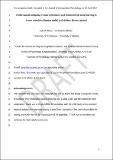Files in this item
Visible spatial contiguity of social information and reward affects social learning in brown capuchins (Sapajus apella) and children (Homo sapiens)
Item metadata
| dc.contributor.author | Wood, Lara Amanda Natalia | |
| dc.contributor.author | Whiten, Andrew | |
| dc.date.accessioned | 2017-08-15T08:45:24Z | |
| dc.date.available | 2017-08-15T08:45:24Z | |
| dc.date.issued | 2017-11 | |
| dc.identifier | 249733724 | |
| dc.identifier | 202d2ba6-ff38-4886-bc96-2cb547075671 | |
| dc.identifier | 85021748464 | |
| dc.identifier | 000415314700004 | |
| dc.identifier.citation | Wood , L A N & Whiten , A 2017 , ' Visible spatial contiguity of social information and reward affects social learning in brown capuchins (Sapajus apella) and children (Homo sapiens) ' , Journal of Comparative Psychology , vol. 131 , no. 4 , pp. 304-316 . https://doi.org/10.1037/com0000076 | en |
| dc.identifier.issn | 0735-7036 | |
| dc.identifier.other | ORCID: /0000-0003-2426-5890/work/65014020 | |
| dc.identifier.uri | https://hdl.handle.net/10023/11463 | |
| dc.description | This work was supported by a John Templeton Foundation grant ID 40128 awarded to A Whiten & K Laland | en |
| dc.description.abstract | Animal social learning is typically studied experimentally by the presentation of artificial foraging tasks. Although productive, results are often variable even for the same species. We present and test the hypothesis that one cause of variation is that spatial distance between rewards and the means of reward release causes conflicts for participants’ attentional focus. We investigated whether spatial contiguity between a visible reward and the means of release would affect behavioral responses that evidence social learning, testing 21 brown capuchins (Sapajus apella), a much studied species with variant evidence for social learning, and 180 two- to four-year old human children (Homo sapiens), a benchmark species known for a strong social learning disposition. Participants were presented with a novel transparent apparatus where a reward was either proximal or distal to a demonstrated means of releasing it. A distal reward location decreased attention towards the location of the demonstration and impaired subsequent success in gaining rewards. Generally, the capuchins produced the alternative method to that demonstrated whereas children copied the method demonstrated, although a distal reward location reduced copying in younger children. We conclude that some design features in common social learning tasks may significantly degrade the evidence for social learning. We have demonstrated this for two different primates but suggest that it is a significant factor to control for in social learning research across all taxa. | |
| dc.format.extent | 1071631 | |
| dc.language.iso | eng | |
| dc.relation.ispartof | Journal of Comparative Psychology | en |
| dc.subject | Social learning mechanisms | en |
| dc.subject | Attention | en |
| dc.subject | Spatial contiguity | en |
| dc.subject | NDAS | en |
| dc.title | Visible spatial contiguity of social information and reward affects social learning in brown capuchins (Sapajus apella) and children (Homo sapiens) | en |
| dc.type | Journal article | en |
| dc.contributor.sponsor | John Templeton Foundation | en |
| dc.contributor.sponsor | John Templeton Foundation | en |
| dc.contributor.institution | University of St Andrews. School of Psychology and Neuroscience | en |
| dc.identifier.doi | 10.1037/com0000076 | |
| dc.description.status | Peer reviewed | en |
| dc.date.embargoedUntil | 2017-05-25 | |
| dc.identifier.grantnumber | 40128 | en |
| dc.identifier.grantnumber | 40128 | en |
This item appears in the following Collection(s)
Items in the St Andrews Research Repository are protected by copyright, with all rights reserved, unless otherwise indicated.

